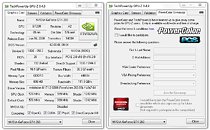
TechPowerUp GPU-Z 0.4.9 Released, PowerColor Giveaway Returns
TechPowerUp today released GPU-Z version 0.4.9, our comprehensive graphics subsystem information and monitoring utility that lets you get important details about the installed graphics hardware in your computer, and lets you monitor parameters such as clock speeds, voltages, temperatures, fan speeds, and usages (on supported GPUs). The latest version of GPU-Z adds support for NVIDIA's upcoming GeForce GTX 570 graphics card, support for detection of PCI-Express 3.0 bus interface, detection of some new upcoming entry-level AMD Radeon HD 6000 series GPUs, and a large number of stability and reliability updates.
With this version, PowerColor and TechPowerUp return with the PowerColor Hardware giveaway. This time we're giving away some even cooler next-generation graphics cards, including two upcoming high-end PowerColor Radeon graphics cards, two PowerColor HD 6870 PCS+, and two PowerColor HD 6850 PCS+ graphics cards. To participate, simply download the latest GPU-Z, and click on the "PowerColor Giveaway", follow the instructions.DOWNLOAD: TechPowerUp GPU-Z 0.4.9
A list of changes follows.
With this version, PowerColor and TechPowerUp return with the PowerColor Hardware giveaway. This time we're giving away some even cooler next-generation graphics cards, including two upcoming high-end PowerColor Radeon graphics cards, two PowerColor HD 6870 PCS+, and two PowerColor HD 6850 PCS+ graphics cards. To participate, simply download the latest GPU-Z, and click on the "PowerColor Giveaway", follow the instructions.DOWNLOAD: TechPowerUp GPU-Z 0.4.9
A list of changes follows.
